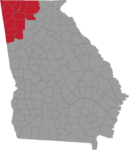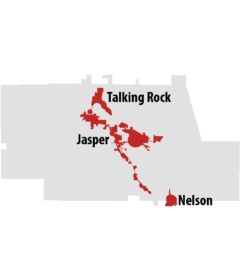 The Northwest Georgia Regional Commission is one of twelve Regional Commissions in the State of Georgia and is also referred to as Region 1. Northwest Georgia Regional Commission proudly serves the 15 counties in our region and the municipalities within those counties. Our member counties along with historical data and other facts are listed below.
The Northwest Georgia Regional Commission is one of twelve Regional Commissions in the State of Georgia and is also referred to as Region 1. Northwest Georgia Regional Commission proudly serves the 15 counties in our region and the municipalities within those counties. Our member counties along with historical data and other facts are listed below.
Bartow County
County Formed: December 3, 1832
County Seat: Cartersville
Incorporated Cities: Adairsville, Cartersville, Emerson, Euharlee, Kingston, Taylorsville and White
Total Area: 459.9 square miles
History:† When Bartow County was established in 1832 from Cherokee County, it was named “Cass County” after Lewis Cass, Secretary of War under President Andrew Jackson. The name was of Michigan. Nearly 30 years later, General Cass’s abolitionist views became an embarrassment to the Confederate populace, and the county’s name was changed to honor General Francis S. Bartow, the first Confederate General to die in the Civil War. Cassville, the original county seat that was burned by Union Forces in 1864, was the site of the first Georgia Supreme Court decision in 1846.
Points of Interest: Red Top Mountain State Park, Bartow Carver Park, and Allatoona Lake occupy a large portion of southeast Bartow County. The lake’s wildlife management area serves as a public hunting area. Other local attractions include the Etowah Indian Mounds, Euharlee Historic Area, Roselawn, Barnsley Gardens, and the Weinman Mineral Museum. The county provides a habitat for one endangered plant, the Jeffersonia Diphylla (Twin Leaf), and three endangered animals: the Indian Bat, the Red Cockaded Woodpecker, and the Southern Bald Eagle.
Notable Citizens: Several notable people have hailed from Bartow County. These include Rebecca Latimer Felton who at the age of 87 became the first woman U.S. senator. She was appointed to fulfill an unfinished term. Sam P. Jones was a nationally known evangelist in the late 1880s. Bill Arp was a famous philosopher and humorist during the Civil War era. Corra Harris, was the author of several books including A Circuit Rider’s Life, based on her life as a traveling minister’s wife.
Higher Education: North Metro Technical Institute and Georgia Highlands College both have satellite campuses in Bartow County.
Catoosa County
County Formed:December 5, 1853
County Seat: Ringgold
Incorporated Cities: Fort Oglethorpe and Ringgold
Total Area: 162.2 square miles
History:† Catoosa County was created from parts of Walker and Whitfield counties. The name Catoosa is derived from the Cherokee “Gatusi,” signifying a prominent hill or point on a mountain. The name is well-suited to Catoosa County’s hilly landscape. The Georgia Winery, famous for its muscadine wines, is located in Catoosa County. Although Fort Oglethorpe is the larger of the two cities, Ringgold is the county seat. Part of Fort Oglethorpe lies in Walker County. The town originally was an Army training center during the two world wars. After the training center was closed in the late 1940s, the city of Fort Oglethorpe was incorporated in 1949.
Points of Interest: The Chickamauga & Chattanooga Military Park, located in Catoosa County and Tennessee, is the oldest and largest military park in the United States. The park commemorates the Battle of Chickamauga fought in 1863. This was one of the bloodiest battles of the Civil War and marked the end of the Union’s first invasion of the Confederacy. Lake Winnepesawkah is rated as one of America’s Top Ten family amusement parks by Travel and Leisure magazine.
Notable Citizens: Randall Franks is a fiddler from Tunnel Hill who appeared in the TV series In the Heat of the Night.
Annual Events: Some of the local festivals in Catoosa County include the 1890 Days Festival in May and the Fairy Tale Festival in Rock City held in August.
Chattooga County
County Formed: December 28, 1838
County Seat: Summerville
Incorporated Cities: Lyerly, Menlo, Summerville and Trion
Total Area: 313.8 square miles
History:† Chattooga County was formed from parts of Floyd and Walker counties. It takes its name from the Chattooga River, one of two Georgia rivers bearing that name. The county courthouse in Summerville was built in 1909 and is listed on the National Register of Historic Places.
Points of Interest: Much of the Armuchee Ranger District, a 65,000-acre section of the Chattahoochee National Forest, lies within the county. Taylor Ridge and Johns Mountain are two of its most prominent features. Over 6,400 acres of Johns Mountain were recently proposed as a National Scenic Area. Some of the more popular recreational activities in the county include hiking, camping, mountain climbing and rappelling in the Lookout Mountain range, and canoeing down the Armuchee Creek. Genealogist and Civil War enthusiasts seek information from the various cemeteries and historical sites. Chattooga Lakes Park is a new park about three miles southeast of Summerville.
Notable Citizens: Several famous people are from Chattooga County. George Guest, known as Sequoyah, was the leader of the Cherokees and is credited with developing the Cherokee written alphabet. Ralph “Country” Brown was a popular center fielder for the Atlanta Crackers baseball team. Brown was inducted into the Georgia Sports Hall of Fame. Bobby Lee Cook, an internationally known and respected trial lawyer, grew up in Chattooga County and has built a major international practice as a defense attorney. Finally, the Reverend Howard Finster, the internationally acclaimed Visionary Artist has his artwork featured at Paradise Gardens.
Annual Events: Some of the festivals and special events held in Chattooga County include the Howard Finster Arts Festival in May, the Sum-Nelly Arts & Crafts Fair in October, “Trick or Treat” Downtown Commerce Street Halloween Walk in October, and the Antique Car Show held every June.
Dade County
County Formed: December 25, 1837
County Seat: Trenton
Incorporated Cities: Trenton
Total Area: 173.9 square miles
History:† Dade County, in Georgia’s extreme northwestern corner, was established in 1837, a year before the federal government began removing the original inhabitants, the Cherokee Indians. Carved from western Walker County, it was the 91st county created in the state. Dade County was named for a Virginian, Major Francis Langhorne Dade, who was killed in 1835 while fighting the Seminoles. Trenton, the county seat, was named after the city in New Jersey. Located on the “Backside of Lookout Mountain,” Dade County was for many years unknown to most Georgians. Until a long-delayed state highway over the mountain was completed in 1948, the only reliable route to the county by automobile was through Alabama or Tennessee. For this reason, the county was known as “The Independent State of Dade.”
Points of Interest: The 2,120-acre Cloudland Canyon State Park is located in Dade County. Encompassing a deep gorge cut by Sitton Gulch Creek, the park has several ridges and valleys for hiking and camping. In the late 1890s Dade County built a new courthouse, jail, and library in downtown Trenton. The old courthouse, a 1926 brick structure listed on the National Register of Historic Places, still stands at the center of the town square. Interstate 59 bisects the county, passing through a scenic valley between the Lookout Mountain and Sand Mountain plateaus.
Annual Events: Several annual events highlight life in Dade County. Dade County Days, held each May in Trenton, feature “down home” food, crafts, and entertainment. The New Salem Mountain Festival is held each May and October, and features hand-made arts and crafts, as well as music and dancing. The World’s Longest Yard Sale is held each May in Trenton. This event spans from Mississippi to Virginia.
Fannin County
County Formed: January 21, 1854
County Seat: Blue Ridge
Incorporated Cities: Blue Ridge, McCaysville, Morganton
Total Area: 385.8 square miles
History:† Fannin County was created in 1854 from parts of Gilmer and Union counties. Georgia’s 106th county was named for Colonel James W. Fannin of Georgia, who, with approximately 350 volunteers, fought in Texas’ War of Independence from Mexico. Fannin and his regiment were captured and massacred in 1836. Fannin’s county seat, Blue Ridge, is named for the southern reach of the Appalachian Mountain Range which stretches into the county. The last remnants of the Cherokee Nation found shelter in the mountains of Fannin County before their removal west along the “Trail of Tears” to Oklahoma in 1838.
Points of Interest: The U.S. Fish and Wildlife Service operates a cold water fish hatchery in Fannin County. The Chattahoochee Forest National Fish Hatchery raises rainbow trout to stock streams, lakes, and reservoirs throughout North Georgia. Parts of the Chattahoochee National Forest and Cohutta National Wilderness Area are in Fannin County. The Cohutta Wilderness Area is the largest national wilderness area east of the Mississippi River. Outdoor recreational opportunities are also plentiful within Fannin County. Campers, hikers, nature lovers, and anglers enjoy the Chattahoochee National Forest and Cohutta Wilderness Area. In addition to these federal facilities, local parks include the Horseshoe Bend Park, the Blue Ridge City Park, and the McCaysville City Park. Water resources are plentiful in Fannin County. Blue Ridge Lake in the center of the county impounds part of the Toccoa River, which flows into Tennessee and becomes the Ocoee River, site of the 1996 Olympic whitewater events. Jacks River, Fightingtown Creek, and Rock Creek also flow through the county. The Blue Ridge Railway is a vintage passenger train running a 26-mile roundtrip along the Toccoa River.
Notable Citizens: Well known country musician, Mark Wills, was raised in Fannin County.
Annual Events: Fannin County residents and visitors enjoy several annual events. Held each Memorial Day weekend, the Arts in the Park Festival in Blue Ridge attracts over 20,000 people. Several local churches in Blue Ridge host an interdenominational Labor Day Barbecue each year at the town’s historic railroad depot. A Mountain Harvest Sale featuring handmade quilts, baskets, and pottery is held on the third and fourth weekends of October at the Blue Ridge State Farmer’s Market. Proceeds from booth fees go to local charities.
Floyd County
County Formed: December 3, 1832
County Seat: Rome
Incorporated Cities: Cave Spring and Rome
Total Area: 513.3 square miles
History:† Floyd County was formed from part of Cherokee County in 1832. Georgia’s 82nd county was named for General John Floyd, a South Carolina Indian fighter and U.S. Congressman. Rome, the county seat, was established in 1834. Floyd County has two historic courthouses, both listed on the National Register of Historic Places. Other places of historic note are Rome’s City Clock, built in 1872; Myrtle Hill Cemetery, listed on the National Register of Historic Places and resting place of Ellen Axson Wilson, wife of President Woodrow Wilson; and the Capitoline Wolf. The original county seat was designated as Livingston in 1833, the county seat was moved to Rome in 1834.
Points of Interest: Cave Spring is known for its antique shops, old residences, and its namesake crystal clear springs. The town features Rolater Park, which includes the world’s largest natural springs swimming pool. Cave Spring is also home to the Georgia School for the Deaf. In northern Floyd County is the $800 million Rocky Mountain pumped storage power plant. Generating enough power for 290,000 households, the plant pumps water to a 550-acre lake on the mountain top, channels the water down a 570-foot vertical shaft and through a 2,500-foot horizontal tunnel to a series of turbines inside the mountain’s base. There are a number of museums in Floyd County including the Chieftans Museum, the Rome Area History Museum and the Eubanks Museum at Shorter College. Located on the Berry College campus are the Martha Berry Museum and Oak Hill, the Berry family home, commemorating the school’s founder and major benefactor.
Notable Citizens: Three Notable Floyd County residents include Martha Berry, noted educator and founder of The Berry School (Berry College); Medora Field Perkerson, author of the “Marie Rose” newspaper column; and Dr. Elizur and Esther Butler, missionaries to the Cherokee Indians.
Higher Education: Berry College, Shorter College, Floyd College and Coosa Valley Technical College.
Annual Events: Floyd County hosts a number of annual events beginning the year with the M.L. King Jr. Celebration in January. During the spring, Rome comes alive for Mayfest on the Rivers and the Memorial Day Celebration. In the fall, there is Heritage Holiday, the Chili Cook Off and the Floyd County Homemaker Annual Christmas Bazaar.
Gilmer County
County Formed: December 3, 1832
County Seat: Ellijay
Incorporated Cities: Ellijay, East Ellijay
Total Area: 426.7 square miles
History:† Gilmer County was created in 1832 from part of Cherokee County. Georgia’s 84th county was named for George Rockingham Gilmer, a State Legislator, member of Congress, and Georgia Governor from 1829 to 1831 and from 1837 to 1839. Ellijay was the site of an Indian village and bears an Indian name meaning “earth green there.” Cherokee Indians lived in this area until their removal in 1838 to Oklahoma via the “Trail of Tears.” Nearly half the territory of Gilmer County is within the Chattahoochee National Forest and is protected from development by the Federal Government.
Points of Interest: Nearly half the territory of Gilmer County is within the Chattahoochee National Forest and is protected from development by the Federal Government. Carters Lake provides a major recreational area in the county. Carters Lake is formed from the Coosawattee River, which is formed from the Cartecay and Ellijay Rivers. The rivers were formerly used for timber operations in the area. Gilmer County boast to be the “Apple Capital of Georgia”. Over 600,000 bushels of apples in 25 varieties are produced annually and sold at numerous roadside stands throughout the county.
Annual Events: Some of the local festivals include the Georgia Apple Festival, the Cherry Log Festival, the Apple Classic Auto Show, and the Gilmer County Fair.
Gordon County
County Formed: February 13, 1850
County Seat: Calhoun
Incorporated Cities: Calhoun, Fairmont, Resaca and Plainville
Total Area: 355.2 square miles
History:† Gordon County was created in 1850 from parts of Floyd and Bartow counties. The 93rd county formed in the state was named after William Washington Gordon, who was president of what was then the Central Railroad and Banking Company and later became the Central of Georgia Railroad. Calhoun was named for Senator John Calhoun. Originally, it was called Dawsonville. Calhoun was virtually wiped out by Sherman’s troops little more than a decade after being incorporated in 1852 but was rebuilt after the war.
Points of Interest: Gordon County is the home of New Echota, which was once the capital of the Cherokee Nation. It was the birthplace of the written Cherokee language and the newspaper, The Cherokee Phoenix. The county has numerous outdoor recreation opportunities. The Chattahoochee National Forest makes up a large part of the western part of the county. The Coosawattee and Conasauga rivers join to form the Oostanaula River, and there is also the Salacoa Creek Park, a 343-acre park with a 126-acre lake.
Notable Citizens: Gordon County was home to Roland Hayes, an internationally recognized classical singer in the 1920s. The Roland Hayes Museum, on the second floor of the new Harris Arts Center, is located in downtown Calhoun.
Higher Education: Coosa Valley Technical College has a satellite campus in Calhoun.
Annual Events: Each year a reenactment of the Battle of Resaca, the first battle on Atlanta Campaign, is held on the third weekend of May.
Haralson County
County Formed: January 26, 1856
County Seat: Buchanan
Incorporated Cities: Bremen, Buchanan, Tallapoosa and Waco
Total Area: 282.2 square miles
History:† Haralson County was created in 1856 from parts of Carroll and Polk counties. Georgia’s 112th county was named for General Hugh A. Haralson, a U.S. Congressman and an officer in the state militia. The old county courthouse, built in 1891 and now home of the local historical society, is a prime example of a public building constructed in the Queen Anne style. The clock tower was added in 1897. Tallapoosa, the “Dogwood City,” was named for the river that runs through Haralson County. Tallapoosa is an Indian word meaning “Golden Water.” Tallapoosa is also known for having opened the first free school in Georgia in 1889.
Notable Citizens: Some notable people from Haralson County are Speaker Thomas B. Murphy, who has held the office of a state Speaker of the House longer than anyone else in the U.S.; Whitlow Wyatt, a former Braves pitcher; and Leroy Almon, a well respected southern folk artist who has had work exhibited by the Smithsonian.
Higher Education: Campus for West Central Technical College located in Waco.
Annual Events: There are several special festivals planned throughout the year in Haralson County. These include the annual Dogwood Festival in April, the Waco Fest in September and the Christmas Tour of Homes in December.
Murray County
County Formed: December 3, 1832
County Seat: Chatsworth
Incorporated Cities: Chatsworth, Eton
Total Area: 344.4 square miles
History:† Murray County, created in 1832 from part of Cherokee County, was named for Thomas Walton Murray, a Speaker of the Georgia House of Representatives. One version of how Chatsworth got its name, is that a sign fell off of a passing freight car. The sign was placed on a pole by the tracks and the name stuck. Among the county’s attractions are the Vann House Historic Site at Spring Place. Constructed in 1805 for James Vann, a Cherokee chief, the two-story red brick home was built alongside the Federal Road, a major early path in northwest Georgia.
Points of Interest: Among the county’s attractions are the Vann House Historic Site at Spring Place. Constructed in 1805 for James Vann, a Cherokee chief, the two-story red brick home was built alongside the Federal Road, a major early path in northwest Georgia. Fort Mountain State Park, an 1,897 acre park in the Cohutta Mountains, is also a popular destination. This area was presented to Georgia in 1934 by Ivan Allen, Sr. for a state park. It includes possibly the oldest fortifications in North America, believed to have been built in 1530 to defend against DeSoto’s men. Another major asset is the Chattahoochee National Forest, which occupies a large portion of northeastern Murray County. Within the forest is the Cohutta Wilderness Area, a roadless, mountainous landscape featuring several of Georgia’s premier backpacking trails. Carter’s Lake, on the Coosawattee River, was formed by the Carter Dam, which is the largest earth-rock dam east of the Mississippi. The 3,200 acre lake attracts fishermen, boaters and campers.
Annual Events: Annual events include the Red and Gold Leaf Festival, Murray County Spring Festival, Appalachian Wagon Train and Village Blackberry Festival. The County also hosts the Georgia State and Red Carpet Championship Mule-Draft Horse Frolic Show which crowns a state champion each year and highlights a wagon show, parade and mule pulling.
Paulding County
County Formed: December 3, 1832
County Seat: Dallas
Incorporated Cities: Braswell, Dallas and Hiram
Total Area: 313.6 square miles
History:† Paulding County, the 87th county created in the state, was formed from part of Cherokee County. It was named after John Paulding, a soldier in the Revolutionary War who helped capture Major Andre, an accomplice in Benedict Arnold’s plot to overthrow the nation. The county courthouse, built in 1892, is listed on the National Register of Historic Places. Another historic site is Pickett’s Mill, a very well preserved Civil War battlefield. In the Atlanta Campaign, Sherman’s forces clashed with Confederates here prior to heading to Kennesaw.
Points of Interest: The Silver Comet Trail, a walking, biking, and skating path with approximately twenty miles of pavement in Paulding County is eventually planned to go from Atlanta to Annistown, Alabama. Paulding County is a popular destination for history buffs because of its well-preserved Civil War memorials. New Hope Church is the site of the 1864 battle between General Sherman and Confederate General Johnston. A monument and memorial park stand at New Hope Church, describing events of this well-known battle.
Notable Citizens: Country music stars Travis Tritt and Patty Loveless are residents of Paulding County.
Annual Events: Along with the civil war reenactments at Pickett’s Mill, the county hosts several other large events including the Paulding Meadows Arts and Crafts Festival, the Hunt’s Meadow Country Fair, the Raccoon Creek Music Festival and the Halloween Trick or Treat Village.
Pickens County
County Formed: December 5, 1853
County Seat: Jasper
Incorporated Cities: Jasper, Nelson, Talking Rock
Total Area: 232.1 square miles
History:† Pickens County was created in 1853 from parts of Cherokee and Gilmer counties. Georgia’s 100th county was named for General Andrew Pickens, a Revolutionary War soldier. A railroad line built in 1883 from Atlanta, through the valleys and mountain passes of Pickens County to Tate and Nelson, made possible the development of large marble quarries. One of the largest marble veins in the world is in Pickens County, running at least four miles long. It is a half-mile deep and almost that wide in places. Over 60 percent of the monuments in Washington, D.C. are made from Pickens County marble.
Higher Education: Appalachian Technical College
Annual Events: Several special events take place in Pickens County. Two of the biggest festivals are held in October: the Marble Festival and Heritage Days Festival in Talking Rock.
Polk County
County Formed: December 20, 1851
County Seat: Cedartown
Incorporated Cities: Aragon, Cedartown and Rockmart
Total Area: 311.2 square miles
History:† Created from parts of Floyd and Paulding counties, Polk County was named for President James K. Polk. Cedartown carries the same name as a Creek Indian town previously found in the area. The name comes from the many Red Cedar trees around the county.
Points of Interest: Rockmart is at the end of a state-owned abandoned railroad line to Atlanta. Polk County has over a 15 mile paved section of the Silver Comet Trail. The first section of the trail starts in Paulding County and heads west to Polk County. The second part of the trail runs from Coot’s Lake Road to historical Downtown Rockmart. The important part of the trail, located in Cedartown, is not paved and still has railroad tracks on the trail. This part of the Silver Comet Trail connects Georgia to the Chief Ladiga Trail in Alabama. Cedartown’s Big Spring is the largest natural limestone spring in the South. Listed on the National Register of Historic Places is the downtown district of Cedartown, an example of 1890s architecture. Also included is the Hawkes Children’s Library, built in 1921. It is now a museum.
Notable Citizens: Ivy Ledbetter Lee, known as the founder of modern public relations, was from Polk County.
Higher Education: Coosa Valley Technical College has a satellite campus in Rockmart.
Annual Events: There are several special events in the county, including the Cedar Valley Arts Festival in May, the Wheel Chair Athlete Camp in June, the Homespun Festival in July, Hightower Falls Festival and Native American Powwow, and the Cedartown Fall Festival in October.
Walker County
County Formed: December 18,1833
County Seat: LaFayette
Incorporated Cities: Chickamauga, LaFayette, Lookout Mountain, and Rossville
Total Area: 446.3 square miles
History:† Walker County, the 99th county created in the state, was formed from part of Cherokee County in 1833. It was named after Major Freeman Walker of Augusta, a lawyer and U.S. Senator. Walker County is home to the John B. Gordon Hall which is the oldest standing brick school building in Georgia, completed in 1836.
Points of Interest: Walker County has two of Georgia’s top 25 tourist attractions: Chickamauga-Chattanooga Battlefield National Park and Rock City Gardens.
Notable Citizens: There are several notable people from Walker County including John Ross who was the “Principle Chief” of the Cherokees for forty years. He also served in the War of 1812 under Andrew Jackson. Another interesting person from Walker County was Garnet Carter, the inventor of the first miniature golf course, which was on top of Lookout Mountain. He was also the leading force behind the Rock City attraction.
Higher Education: Northwestern Technical College and Covenant College.
Annual Events: Some of the local festivals are the John Ross Festival, Chickamauga Christmas in the Streets, Downtown Days, the Freedom Festival and the LaFayette Downtown Christmas Parade.
Whitfield County
County Formed: December 30, 1851
County Seat: Dalton
Incorporated Cities: Dalton, Cohutta, Tunnel Hill, Varnell
Total Area: 290 square miles
History:† Whitfield County was formed from part of Murray County in 1851. Georgia’s 97th county was named for the Reverend George Whitefield, the founder of the Bethesda Orphan House in Savannah. The spelling of the county’s name was changed to reflect the way it was pronounced. Dalton is the gateway to the 150 mile Chieftain’s Trail which traces the path of the Cherokee Indian sites located in northwest Georgia.
Points of Interest: The Creative Arts Guild, the Dalton-Whitfield Commission for the Arts, is the oldest local community arts agency in Georgia. The area is very rich in Civil War history with 32 historical markers, more than any other Georgia county. Also located in the county is the only known statue of General Joseph E. Johnston.
Higher Education: Dalton State College, a two-year unit of the University System of Georgia, is also located in the county.
Annual Events: Some of the local festivals include the Prater‘s Mill Country Fair, Kudzo Festival, and the CAG Fine Arts Festival.
† Source: Department of Community Affairs











































































































